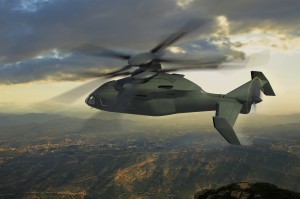We Defy You to Ride the SB>1 Simulator With Us
Posted on
AUSA: As a rule of thumb, the aerodynamics of rotor blades limit helicopters to top cruising speeds well under 200 mph, but Sikorsky and Boeing are building an aircraft they promise will thumb its nose at that rule. It’s a compound helicopter – two coaxial rotors and a pusher propeller – that they promise will speed through the air at nearly 300 mph and hover like a hummingbird.
They call it the SB>1 Defiant – the company-chosen designation means “Sikorsky and Boeing are greater than one” – and I flew one yesterday in a demonstration ride Boeing brought to the Association of the United States Army convention.

The Sikorsky-Boeing SB-1 Defiant concept for the Joint Multi-Role demonstrator, a predecessor to the Future Vertical Lift aircraft.
“The primary advantage that Defiant’s going to offer over a traditional helicopter is, it’s got twice the speed, two to three times the range, and is just an extremely maneuverable and agile platform,” said retired Marine Maj. Frank P. Conway, Boeing’s experimental test pilot for both the SB>1 and the V-22 Osprey tiltrotor. Conway, who was a V-22 test pilot in the Marine Corps as well, flew me on a simulated ride in the SB>1. He calls the Defiant “a very hot, sexy aircraft.”
Lockheed Martin’s subsidiary Sikorsky and the Boeing Co. are still fabricating parts for the first Defiant, which is their entrant in the Army-run Joint Multi-Role Technology Demonstration (JMR TD) program. JMR TD is the first tangible project launched under the joint Future Vertical Lift initiative, which aims to take rotorcraft of all sizes beyond the boundaries of helicopters. Competing with the Defiant to win the hearts and minds of the military services and become the next medium-sized military vertical lift aircraft is Bell Helicopter’s V-280 Valor tiltrotor, whose simulator was featured Monday on BD. The Valor is under construction at Amarillo, Texas.
The Defiant, which Sikorsky and Boeing plan to start assembling later this year at Sikorsky’s West Palm Beach, Fla., plant, is derived from Sikorsky’s award-winning X2 technology demonstrator but will be far larger – big enough to carry a dozen troops. It defeats “retreating blade stall” and other limits on normal helicopter speed by using two 25-foot-diameter coaxial rotors spinning in opposite directions and an 11-foot-diameter pusher propeller. The coaxial rotors eliminate the need for a tail rotor, leaving plenty of room for the propeller.
The result, if the actual aircraft flies the way the computer simulation depicts, will be “eye watering,” Conway said. Grab a hanky and see for yourself in the video above.
Subscribe to our newsletter
Promotions, new products and sales. Directly to your inbox.
